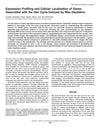TLDR Runx1 affects hair growth, cancer development, and autoimmune diseases in epithelial tissues.
The document discussed the role of the transcription factor Runx1 in epithelial stem cell biology and pathology, particularly in hair follicles (HFs) and other epithelial tissues. Runx1 was crucial for hair cycling and wound healing in mice, with its expression pattern conserved in humans. It regulated Stat3 by repressing cytokine-signaling suppressors, affecting normal hair cycling. Runx1's role extended to other epithelial tissues like nails and oral epithelium, contributing to stem cell maintenance. Additionally, Runx1 was implicated in autoimmune diseases and various cancers, including skin squamous cell carcinoma (SCC), where it was essential for tumor growth and survival. The findings suggested that targeting Runx1 could be a potential strategy for treating SCC and other cancers.
161 citations
,
August 2012 in “Seminars in cell & developmental biology” Hair growth and development are controlled by specific signaling pathways.
 759 citations
,
February 2009 in “Current Biology”
759 citations
,
February 2009 in “Current Biology” Hair follicles are complex, dynamic mini-organs that help us understand cell growth, death, migration, and differentiation, as well as tissue regeneration and tumor biology.
46 citations
,
August 2006 in “Mechanisms of Development” Runx1 is crucial for proper hair structure and development.
6 citations
,
January 2006 in “Journal of dermatological science” Runx1 helps control the KAP5 gene in human hair follicles.
 27 citations
,
August 2005 in “The journal of investigative dermatology/Journal of investigative dermatology”
27 citations
,
August 2005 in “The journal of investigative dermatology/Journal of investigative dermatology” Researchers found new genes involved in hair growth, which could help develop new hair treatments.
555 citations
,
July 2001 in “Genes & Development” Tcf3 and Lef1 are key in deciding skin stem cell roles.
73 citations
,
November 2000 in “Proceedings of the National Academy of Sciences of the United States of America” There are two ways to start hair growth: one needs Stat3 and the other does not, but both need PI3K activation.
 April 2019 in “Journal of Investigative Dermatology”
April 2019 in “Journal of Investigative Dermatology” Wnt-signaling is regulated differently in skin cells and immune responses during wound healing.


